The Caribbean Island Of Trinidad and Tobago
|
|
 The Republic of Trinidad and Tobago is an
archipelagic state in the southern Caribbean, lying northeast of the South American country of
Venezuela and south of Grenada in the Lesser Antilles. It shares maritime boundaries with
other nations including: Barbados to the northeast, Guyana to the southeast, and Venezuela to
the south and west.[4][5] The country covers an area of 5,128 square kilometers (1,980 sq mi)
and consists of two main islands, Trinidad and Tobago, and numerous smaller landforms.
Trinidad is the larger and more populous of the main islands; Tobago is much smaller,
comprising about 6% of the total area and 4% of the population. The nation lies outside the
hurricane belt. The Republic of Trinidad and Tobago is an
archipelagic state in the southern Caribbean, lying northeast of the South American country of
Venezuela and south of Grenada in the Lesser Antilles. It shares maritime boundaries with
other nations including: Barbados to the northeast, Guyana to the southeast, and Venezuela to
the south and west.[4][5] The country covers an area of 5,128 square kilometers (1,980 sq mi)
and consists of two main islands, Trinidad and Tobago, and numerous smaller landforms.
Trinidad is the larger and more populous of the main islands; Tobago is much smaller,
comprising about 6% of the total area and 4% of the population. The nation lies outside the
hurricane belt.
Unlike most of the English-speaking Caribbean, Trinidad and Tobago's economy is primarily
industrial-based, with an emphasis on petroleum and petrochemicals. It is an independent Caribbean
country, with a good standard of living and high literacy rates.
Trinidad and Tobago is famous for its pre-Lenten festival known as Carnival and as the birthplace
of steelpan, calypso, soca, and limbo.
|
Trinidad and Tobago History
|
|
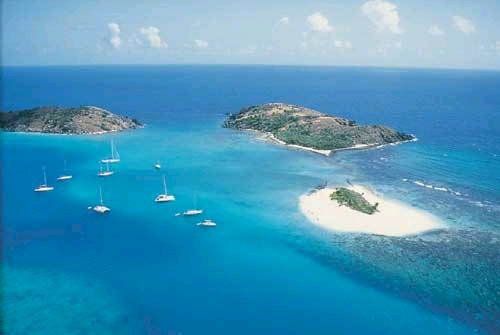
Both Trinidad and Tobago were originally settled by Amerindians of South American origin.
Trinidad was first settled by pre-agricultural Archaic people at least 7,000 years ago, making it
the earliest-settled part of the Caribbean. Ceramic-using agriculturalists settled Trinidad around
250 BC and then moved further up the Lesser Antillean chain. At the time of European contact
Trinidad was occupied by various Arawakan-speaking groups including the Nepoya and Suppoya, and
Cariban-speaking groups such as the Yao, while Tobago was occupied by the Island Caribs and
Galibi.
Christopher Columbus encountered the island
of Trinidad on July 31, 1498. Columbus reported seeing Tobago, which he named Bella Forma, but did
not land on the island. Antonio de Sedeño first settled Trinidad in the 1530s as a means of
controlling the Orinoco and subduing the Warao (Whitehead, 1997).
Cacique Wannawanare (Guanaguanare) granted the St Joseph area to Domingo de Vera e Ibargüen in
1592 and then withdrew to another part of the island (Boomert, 2000). San José de Oruña (St Joseph)
was established by Antonio de Berrío on this land. Walter Raleigh arrived in Trinidad on March 22
1595 and soon attacked San José and captured and interrogated de Berrío obtaining much information
from him and from the cacique Topiawari (Whitehead, 1997). In the 1700s, Trinidad belonged as an
island province to the vice royalty of New Spain along with modern Mexico and Central America
(Besson, 2000). However Trinidad in this period was still mostly forest, populated by a few
Spaniards with their handful of slaves and a few thousand Amerindians (Besson, 2000). Spanish
colonisation in Trinidad remained tenuous.
|
|
Because Trinidad was considered underpopulated, Roume de St. Laurent, a Frenchman living in
Grenada, was able to obtain a Cédula de Población from the Spanish King Charles III on the 4th
November, 1783. This Cédula de Población was more generous than the first of 1776 and granted free
lands to Roman Catholic foreign settlers and their slaves in Trinidad willing to swear allegiance
to the Spanish king. The land grant was thirty two acres for each man, woman and child and half of
that for each slave brought. As a result, Scots, Irish, German, Italian and English families
arrived. The Protestants among them profited from Governor Don José Maria Chacon's generous
interpretation of the law. The French Revolution (1789) also had an impact on Trinidad's culture
since it resulted in the emigration of Martiniquan planters and their slaves to Trinidad who
established an agriculture-based economy (sugar and cocoa) for the island.[6]
The population of Puerto de España (Port of Spain) increased from under 3,000 to 10,422 in five
years and the inhabitants in 1797 consisted of mixed-races, Spaniards, Africans, French republican
soldiers, retired pirates and French nobility (Besson, 2000). The total population of Trinidad in
1797 was 17,718; 2,151 of which were "white", 4,476 were "free blacks and people of colour", 10,009
were slaves and 1,082 Amerindians.
Independence
Trinidad and Tobago became an independent nation (from the United Kingdom) in 1962. The presence of
American military bases in Chaguaramas and Cumuto in Trinidad during World War II profoundly
changed the character of society. In the post-war period, the wave of decolonisation that swept the
British Empire led to the formation of the West Indies Federation in 1958 as a vehicle for
independence. Chaguaramas was the proposed site for the federal capital. The Federation dissolved
after the withdrawal of Jamaica, and Trinidad and Tobago elected for independence in 1962.
In 1976, the country severed its links with the British monarchy and became a republic within
the Commonwealth, though it retained the British Privy Council as its final Court of Appeal.
Between the years 1972 and 1983, the Republic profited greatly from the rising price of oil, as the
oil-rich country increased its living standards greatly. In 1990, 114 members of the Jamaat al
Muslimeen, led by Yasin Abu Bakr, formerly known as Lennox Phillip, stormed the Red House (the seat
of Parliament), and Trinidad and Tobago Television, the only television station in the country at
the time, and held the country's government hostage for six days before surrendering.
Since 2003, the country has entered a second oil boom, a driving force which the government
hopes to use to turn the country's main export back to sugar and agriculture. Great concern was
raised in August 2007 when it was predicted that this boom would last only until 2018. Petroleum,
petrochemicals and natural gas continue to be the backbone of the economy. Tourism is the mainstay
of the economy of Tobago, and the island remains a favourite destination for many European
tourists. Trinidad and Tobago is one of the most prosperous and stable democratic nations in the
Caribbean.
|
Geography
|
|

Trinidad and Tobago are southeasterly islands of the Antilles, situated between 10°
2' and 11° 12' N latitude and 60° 30' and 61° 56' W longitude. At the closest point, Trinidad is
just 11 kilometres (6.8 mi) off the Venezuelan coast. Covering an area of 5,128 km2 (1,980 sq mi),
the country consists of the two main islands, Trinidad and Tobago, and numerous smaller landforms -
including Chacachacare, Monos, Huevos, Gaspar Grande (or Gasparee), Little Tobago, and St. Giles
Island.
Trinidad is 4,768 km2 (1,841 sq mi) in area (comprising 93.0% of the country's total area) with
an average length of 80 km (50 mi) and an average width of 59 kilometres (37 mi). Tobago has an
area of about 300 km2 (120 sq mi), or 5.8% of the country's area, is 41 km (25 mi) long and 12 km
(7.5 mi) at its greatest width. Trinidad and Tobago lie on the continental shelf of South America,
and is thus geologically considered to lie entirely in South America. However the Caribbean islands
are generally considered to part of North America, and as the language and cultural links of
Trinidad and Tobago are not to South America but to the rest of the English speaking Caribbean
nations, the nation is often treated as part of North America.
The terrain of the islands is a mixture of mountains and plains. The highest point in the
country is found on the Northern Range at El Cerro del Aripo which is 940 m (3,100 ft) above sea
level. The climate is tropical. There are two seasons annually: the dry season for the first six
months of the year, and the wet season in the second half of the year. Winds are predominantly from
the northeast and are dominated by the northeast trade winds. Unlike most of the other Caribbean
islands, both Trinidad and Tobago have frequently escaped the wrath of major devastating hurricanes
including Hurricane Ivan, the most powerful storm to pass close to the islands in recent history in
September 2004.
As the majority of the population live in Trinidad, this is the location of most major towns and
cities. There are three major municipalities in Trinidad: Port of Spain, the capital, San Fernando,
and Chaguanas. The main town in Tobago is Scarborough.
The Northern Range consists mainly of Upper Jurassic and Cretaceous metamorphic rocks. The
Northern Lowlands (East-West Corridor and Caroni Plains) consist of younger shallow marine clastic
sediments. South of this, the Central Range fold and thrust belt consisits of Cretaceous and Eocene
sedimentary rocks, with Miocene formations along the southern and eastern flanks. The Naparima
Plains and the Nariva Swamp form the southern shoulder of this uplift.
The Southern Lowlands consist of Miocene and Pliocene sands, clays, and gravels. These overlie
oil and natural gas deposits, especially north of the Los Bajos Fault. The Southern Range forms the
third anticlinal uplift. It consists of several chains of hills, most famous being the Trinity
Hills. The rocks consist of sandstones, shales and siltstones and clays formed in the Miocene and
uplifted in the Pleistocene. Oil sands and mud volcanoes are especially common in this area.
Although it is located just off-shore from South America, Trinidad and Tobago is generally
included as part of the West Indies by virtue of its geographical and historical heritage in the
Caribbean.
|
Economy
|
|
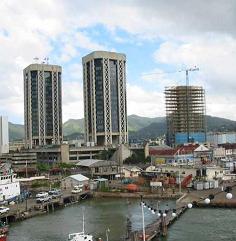
Trinidad's economy is strongly influenced by the petroleum industry. Tourism and manufacturing
are also important to the local economy.Tourism is a growing sector, although not proportionately
as important as in many other Caribbean islands. Agricultural products include citrus, cocoa, and
other products. Sugar cane was once a prominent crop of Trinidad but commercial production has
ceased since 2007.
Trinidad and Tobago has earned a reputation as an excellent investment site for international
businesses and has one of the highest growth rates and per capita incomes in Latin America. Recent
growth has been fueled by investments in liquefied natural gas (LNG), petrochemicals, and steel.
Additional petrochemical, aluminum, and plastics projects are in various stages of planning.
Trinidad and Tobago is the leading Caribbean producer of oil and gas, and its economy is heavily
dependent upon these resources but it also supplies manufactured goods, notably food and beverages,
as well as cement to the Caribbean region.
Oil and gas account for about 40% of GDP and 80% of exports, but only 5% of employment. The
country is also a regional financial center, and the economy has a growing trade surplus. The
expansion of Atlantic LNG over the past six years created the largest-single sustained phase of
economic growth in Trinidad and Tobago. It has become the leading exporter of LNG to the United
States, and now supplies some 70% of U.S. LNG imports
Telephone service is relatively modern and reliable. Cellular service is widespread and has been
the major area of growth for several years. Digicel and Laqtel were granted cellular licenses in
2005, breaking TSTT's monopoly.
Language:
English is the country's only official language, but the main spoken language is a dialect or a
creole which reflects the Spanish, Indian, African and European heritage of the nation and is
spoken by all Trinidadians regardless of ethnicity.
.
Because of the country's colonial heritage, the names of towns in Trinidad are in roughly equal
proportions of English (Chatham, Brighton, Green Hill, St. Mary's, Princes Town, Freeport, New
Grant), French (Blanchisseuse, Sans Souci, Pointe-à-Pierre, Basse Terre, Matelot, Petit Bourg),
Spanish (Puerto España, San Fernando, Sangre Grande, Rio Claro, San Juan, Las Cuevas, Maracas,
Manzanilla, Los Bajos) East Indian (Fyzabad, Barrackpore, Indian Walk, Madras Settlement, Penal,
Debe) and Amerindian languages (Chaguanas, Tunapuna, Guayaguayare, Carapichaima, Mucurapo,
Chaguaramas, Arima, Arouca, Guaico, Oropouche, Aripo). In Tobago, English names predominate.
However, there are several names which suggest its colonial past: Belle Garden, Bon Accord,
Charlotteville, Les Coteaux, Parlatuvier (French), Auchenskeoch, Blenheim (Dutch).
Culture
It is also the birthplace of calypso music and the steelpan, which is widely claimed in Trinidad
and Tobago to be the only acoustic musical instrument invented during the 20th century.[18] The
diverse cultural and religious background allows for many festivities and ceremonies throughout the
year. Other indigenous art forms include soca (a derivate of calypso), Parang
(Venezuelan-influenced Christmas music), Chutney, Rapso music, which was made famous by Cheryl
Byron and Pichakaree (musical forms which blend the music of the Caribbean and India) and the
famous Limbo dance.
The artistic scene is vibrant. Trinidad and Tobago claims two Nobel Prize-winning authors, V.S.
Naipaul and St Lucian-born Derek Walcott. Edmundo Ros, the 'King of Latin American Music', was born
in Port of Spain. Mas' designer Peter Minshall is renowned not only for his Carnival costumes, but
also for his role in opening ceremonies of the Barcelona Olympics, the 1994 Football World Cup, the
1996 Summer Olympics and the 2002 Winter Olympics, for which he won an Emmy Award.
|
The Flag and Coat of arms of Trinidad and Tobago
|
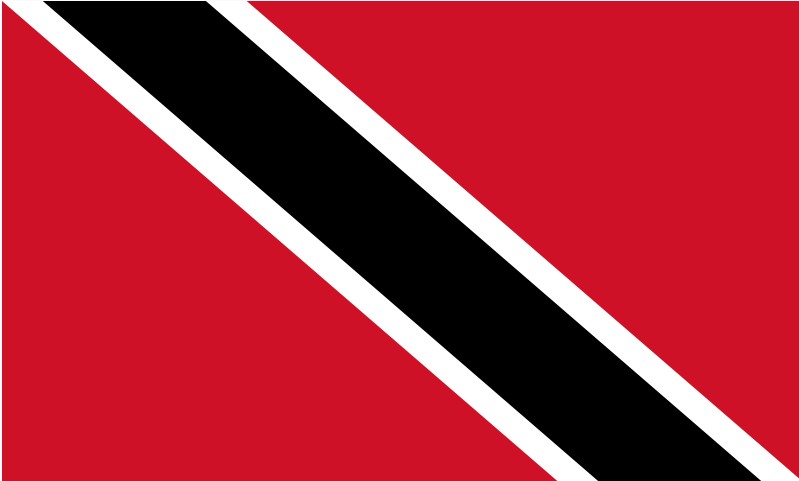 The flag of Trinidad and
Tobago was adopted upon independence in 1962. The red represents the vitality of
the land and the people. The warmth, strength and energy of the sun, and the
courage & friendliness of the people. The white stands for the sea by which
the land is bound.The cradle of our heritage. The purity of national aspirations
and the equality of all men. The black represents strength, unity and purpose. The
natural wealth of the land. The dedication of the people joined together by one
strong bond. Together the colours chosen represent the elements Earth , Water and
Fire which encompass all our past, present and future and inspire us as one
united, vital, free and dedicated people. The flag of Trinidad and
Tobago was adopted upon independence in 1962. The red represents the vitality of
the land and the people. The warmth, strength and energy of the sun, and the
courage & friendliness of the people. The white stands for the sea by which
the land is bound.The cradle of our heritage. The purity of national aspirations
and the equality of all men. The black represents strength, unity and purpose. The
natural wealth of the land. The dedication of the people joined together by one
strong bond. Together the colours chosen represent the elements Earth , Water and
Fire which encompass all our past, present and future and inspire us as one
united, vital, free and dedicated people. |
|
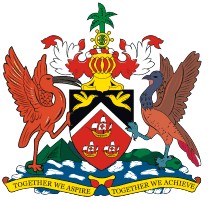 Coat of arms of Trinidad and Tobago Coat of arms of Trinidad and Tobago
The Coat of Arms of Trinidad and Tobago was designed by a committee formed in
1962 to select the symbols that would be representative of the people of Trinidad
and Tobago. The committee included noted artist Carlisle Chang and the late
designer George Bailey. The palm tree at the top of the Coat of Arms was taken from
Tobago's Coat of Arms before it was joined in political union with Trinidad. The
wreath represents the crown of the monarchy of the United Kingdom, Trinidad and
Tobago's colonizers at the time of independence. The shield has the same colours
(black, red, and white) of the nation's flag and carry the same meaning. The gold
ships represent the Santa Maria, Nina, and Pinta: the three ships Christopher
Columbus used on his journey to the "New World." The two birds on the shield are
hummingbirds.
Trinidad is sometimes referred to as the "Land of the Hummingbird" because more
than sixteen different species of hummingbird have been recorded on the island.
"Land of the Hummingbird" is also believed to have been the Native American name
for Trinidad. The two larger birds are the Scarlet Ibis (left) and the Cocrico
(right), the national birds of Trinidad and Tobago. Below the Scarlet Ibis are
three hills, representing the Trinity Hills in southern Trinidad, which, it is
believed, convinced Columbus to name the island after the Holy Trinity. The island
rising out of the waters beneath the Cocrico represents Tobago. Below these birds
is the nation's motto, "Together We Aspire, Together We Achieve."
{Credit} http://en.wikipedia.org/
|
|
|
|
|

2. Celebrate
Carnival, Trinidad's most
wild and colourful event. The world-renowned festivities climax at the beginning of Lent,
although the run-up to Carnival starts immediately after Christmas when the Calypso tents open
and the Calypsonians perform their latest compositions and arrangements.
Listen to the big steel bands bang their drums around Queen's Park Savannah, a large park in Port
of Spain. Panorama, the Grand Steel Drum (pan) tournament is staged a week before Carnival. The
preliminaries and local finals in Tobago are also well worth a visit.
2. Take to the streets
of Port of Spain, San Fernando and Tunapuna with the islands' Muslim
population to celebrate Hosay, which coincides with the Muslim New Year. Multi-coloured miniature
mausoleums are paraded and then ritually offered up to the ocean.
3. Treat your taste buds in the rapidly
expanding town of Chaguanas where a wide range of West Indian culinary specialities are
available.
See some of the islands' 622 species of butterfly and over 700 species of orchid. The latter are
best seen in Port of Spain's Royal Botanic Gardens (along with a wide selection of indigenous
trees, shrubs, ferns and cacti). The Emperor Valley Zoo has a good selection of local wildlife.
4. Spot the national bird, the scarlet ibis,
in Trinidad's Nariva Swamp, the Aripo Savannah, the Asa Wright Nature Centre and the Caroni Bird
Sanctuary where it is conserved. Hummingbirds are ubiquitous on Tobago and Little Tobago Island is
highly recommended for twitchers.
5. Catch a game of cricket, the major
spectator sport, at the Queen's Park Oval in Port of Spain, where the best national and
international matches can be seen. Trinidadians are keen on racing, and the Arima Velodrome hosts a
number of major meetings.
6. Take advantage of the excellent watersports
facilities at the beaches along the north and east coasts of Trinidad, and all around Tobago.
Speyside and Buccoo Reef, just off the southwest coast of Tobago, which has some of the Caribbean's
finest reefs, offer exciting scuba-diving. Trips in glass-bottomed boats are very popular.
7. Fish for Spanish mackerel, wahoo, kingfish,
bonito, dolphin fish, yellow tuna, grouper, salmon and snapper in the islands' abundant waters.
Both deep-sea and freshwater fishing are rewarding and there is an increasing number of boats
available for hire.
|
Getting Married In trinidad and-Tobago
|
|
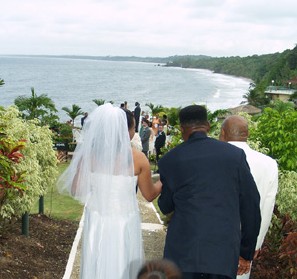
The information below outlines the marriage requirements for getting married in Trinidad &
Tobago
* Three days' residence in the country must be established (calculated from the day after the date
of arrival)
* Both parties must attend of the offices listed below not less than 24 hours before intended time
of marriage to make a statutory declaration and pay fees. office hours are 8:30am to 3pm
Documents Required
* Proof of residence - passport and airline tickets
* Identification of applicants - passport
* If divorced, original or notarized copy of degree absolute
* If widowed, original deaths certificate of spouse.
* Deed poll or other proofs of name change where name differs on documents
NB. A notarized English translation is required if documents are not in English.
Fees: The license costs TT$337.50 (US$51) which is payable in cash or in postage stamps obtainable
from the General Post Office.
Registrars Offices
The registrar's office should be contacted for specific rules regarding planning your
destination or beach wedding in Trinidad & Tobago. They will also provide information regarding
marriage licenses and marriage certificates.
Trinidad Registrar General's Office
Registrar House
72 - 74 South Quay
Port of Spain
Tel: 868 623 7163
Tobago Warden's Office Inland Revenue Bldg
Sangster's Hill
Scarborough
Tel: 868 639 2410
{redit} http://www.islandbrides.com
|
Trinidad and
Tobago Weather | Attractions-Trinidad and
Tobago
Trinidad and Tobago
Accommodation | Shopping-Trinidad and Tobago
Transportations in Trinidad and
Tobago | Trinidad and Tobago Airports
Trinidad
and Tobago Carnival | Trinidad and Tobago
Casinos | Nightlife in Trinidad and Tobago
Restaurants in
Trinidad | Restaurants in Tobago |
Scuba Diving -Trinidad
& Tobago
|
 The Republic of Trinidad and Tobago is an
archipelagic state in the southern Caribbean, lying northeast of the South American country of
Venezuela and south of Grenada in the Lesser Antilles. It shares maritime boundaries with
other nations including: Barbados to the northeast, Guyana to the southeast, and Venezuela to
the south and west.[4][5] The country covers an area of 5,128 square kilometers (1,980 sq mi)
and consists of two main islands, Trinidad and Tobago, and numerous smaller landforms.
Trinidad is the larger and more populous of the main islands; Tobago is much smaller,
comprising about 6% of the total area and 4% of the population. The nation lies outside the
hurricane belt.
The Republic of Trinidad and Tobago is an
archipelagic state in the southern Caribbean, lying northeast of the South American country of
Venezuela and south of Grenada in the Lesser Antilles. It shares maritime boundaries with
other nations including: Barbados to the northeast, Guyana to the southeast, and Venezuela to
the south and west.[4][5] The country covers an area of 5,128 square kilometers (1,980 sq mi)
and consists of two main islands, Trinidad and Tobago, and numerous smaller landforms.
Trinidad is the larger and more populous of the main islands; Tobago is much smaller,
comprising about 6% of the total area and 4% of the population. The nation lies outside the
hurricane belt.


 The flag of Trinidad and
Tobago was adopted upon independence in 1962. The red represents the vitality of
the land and the people. The warmth, strength and energy of the sun, and the
courage & friendliness of the people. The white stands for the sea by which
the land is bound.The cradle of our heritage. The purity of national aspirations
and the equality of all men. The black represents strength, unity and purpose. The
natural wealth of the land. The dedication of the people joined together by one
strong bond. Together the colours chosen represent the elements Earth , Water and
Fire which encompass all our past, present and future and inspire us as one
united, vital, free and dedicated people.
The flag of Trinidad and
Tobago was adopted upon independence in 1962. The red represents the vitality of
the land and the people. The warmth, strength and energy of the sun, and the
courage & friendliness of the people. The white stands for the sea by which
the land is bound.The cradle of our heritage. The purity of national aspirations
and the equality of all men. The black represents strength, unity and purpose. The
natural wealth of the land. The dedication of the people joined together by one
strong bond. Together the colours chosen represent the elements Earth , Water and
Fire which encompass all our past, present and future and inspire us as one
united, vital, free and dedicated people.  Coat of arms of Trinidad and Tobago
Coat of arms of Trinidad and Tobago

